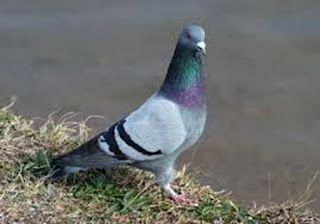I used to raise pigeons. Dad built me a pigeon coop on the back of the garage. It was about three feet by three feet by nine feet, with nesting boxes in one end, and hung up under the eaves. It was sturdy enough I could climb up into it and sit with the birds.
I started with homing pigeons. They look a lot like the pigeons you see flying around wild.
The pigeon coop has to have a “trap”. That’s a way for the birds to get back in the coop, but critters other than pigeons can’t get in. It is typically a platform for the bird to land on, next to an opening in the coop, with wires hanging down that the bird can push through to get in, but can’t push the other way to get back out again.
Once the birds were taught to “trap” (that’s a noun and a verb), we would take them progressively farther away to release them, and see if they found their way home. Most did. Probably the farthest away we got was twenty-five miles when Dad would take a basket of pigeons to work with him in the morning and release them. It would take several hours for them to make it home.
Later on, I started buying and raising fancy pigeons. Fantails, helmets, tumblers (not really fancy, just deranged), and frillbacks. Frillbacks were my specialty. Most other fancy pigeons could be bought for seven or eight dollars a pair. Frillbacks cost fifteen!
The reason this all comes up is because I was at the Edinburg Municipal Park the other day and came across this bird.
It’s a wild pigeon, but it certainly has some fantail blood in it.
I don’t have any photos of the pigeons from my childhood, so I picked a few off the internet to illustrate.
Homing pigeon.
Fantail.
Helmet.
Pouter.
Swallow.
And my beloved Frillbacks.
Most of my pigeons came from a guy out in Artesia. Mom would drive me out there to spend the paper-route money I had saved up. I don’t remember much about him except that he was really old; probably fifty or so. Artesia was out in the country then, so he had plenty of room in his backyard for extensive walk-in pigeon coops. He was patient and would walk me all around the coops so I could pick out the birds I wanted that day. I wonder now if that’s something he enjoyed; waiting out a kid’s decision; sharing in the excitement and discovery, or something he just needed to do to support *his* pigeon habit.
I got these birds back to my loft and bred them to sell to kids around the neighborhood. Instead of paying attention in class, I worked out the arithmetic for how many clutches a pair of pigeons could produce each year and how many pigeons I’d have to breed to have a thousand dollars-worth, or ten thousand dollars-worth. I realize now I was only counting inventory, not considering the cost of housing and feeding those prospective birds.
I think the pigeons must have gone away around the time I got a car.









No comments:
Post a Comment